Laurie and her husband Bryan started blogging 10 years ago when they went on a year-long trip. Their website has changed over time and now contains tools to plan and track your travel budget, and then it congregates all the tracked budgets to estimate the costs of different places around the world.
Before diving into SEO and monetization, it’s crucial to understand that you first need to have unique content that targets your audience. From the very beginning, think about keywords that will lead users to your website and develop traffic sources. Then you need to consider monetization strategies.
Diversify traffic sources
In the webinar [01:45], Laurie describes different traffic sources that you may adhere to in order to keep your blog afloat.
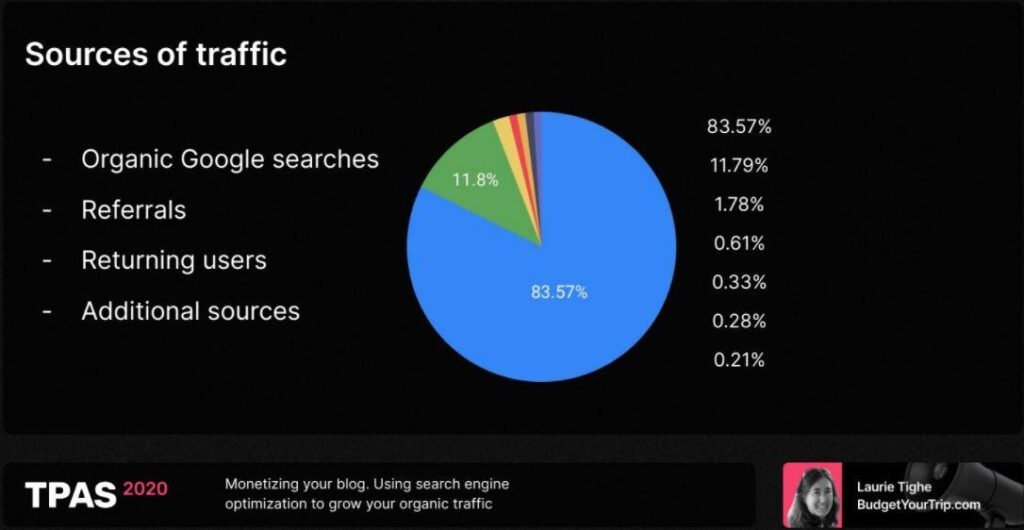
The biggest source of new users and a favourite of ad networks is organic Google searches. This is driven by SEO and works best when your ranking has already grown. Then, Google will bring you real revenue.
Another traffic source is referrals, which is great to grow your Google ranking and bump up traffic. However, the effect wears off as the referral link can be archived and no longer available.
Also, you may have returning users. If so, you know that your content retains users and helps grow a loyal audience. Returning users do not bring much money but they help to spread the word about your blog and expand your target audience.
Newsletter subscriptions can also enhance your relationship with your audience and gain loyal followers. Try to insert some advertisements inside the newsletter to generate revenue.
Social media may also become a promotion platform for your content, as it is lucrative for many influencers. However, bear in mind that this is constantly changing, so you need to keep up.
Lots of people try paid ads but you have to check whether this will work for you. In some cases, the cost might not be worth the benefit.
Understand your users
There are two types of users that usually comprise an audience. The first group are users who already know what they are looking for and are one step away from completing their purchase. This audience segment serves immediate website monetisation, and you want your affiliate ads to strike in this case.
Then there are users who are still doing their background research and have not made a choice yet. For this audience, it’s more efficient to use ad networks, like Google AdSense.
Laurie explains [05:25] that depending on the audience, your content needs to follow one of these strategies. So, first you need to figure out what type of user can be attracted to your particular page and set up monetization accordingly.
Choose the right keywords
With that in mind, proceed to choosing the right keywords. An uncertain visitor tends to search broader keywords, while users ready to purchase are more likely to use very specific keywords. For them you can offer the affiliate programs that you advertise on your website.
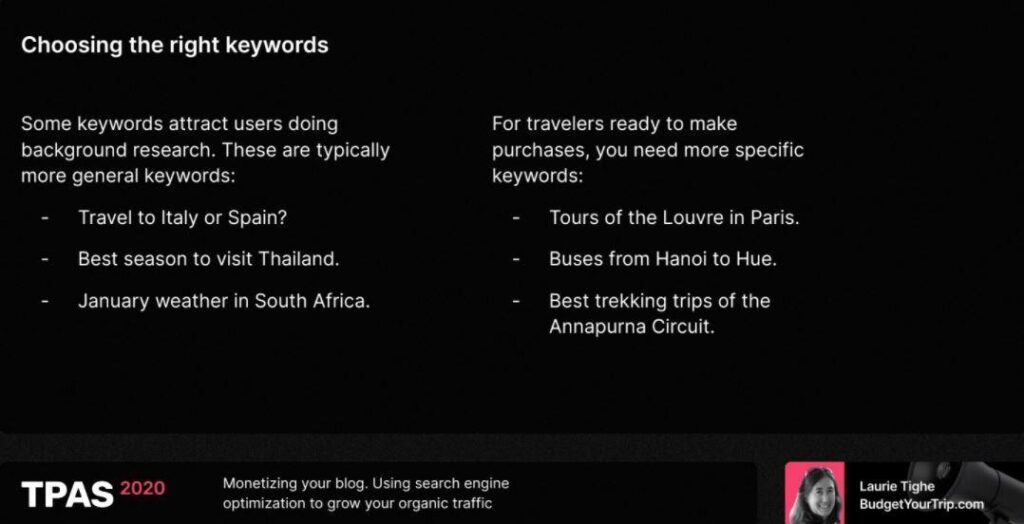
There are different types of keywords that you can use. In the webinar [07:58], Laurie divides them into three categories:
- Broader keywords, or Head (one or two words) drive most of the searches; for example, “Spain Travel” or “Visiting Peru”. The pages with such keywords are the most competitive. This category is more suitable and effective for big blogs and companies.
- “Moderate” keywords, or Body (two or three words) are more descriptive and bring in a decent amount of traffic; for instance, “Tours of Costa Rica” or “Masai Mara Tour Operators”. With this category, you may rank very high in Google searches.
- Long (niche) keywords, or Longtail (more than three words) are low-competition, very specific and with them you can rank high very quickly; for example, “Angkor Wat Tours for Kids” or “Affordable Charleston Historical Tours”. They target a specific audience and work best for websites in a particular niche.
Other categories of keywords:
- Navigational keywords are brand-specific words. They have to be in your URL and throughout your website. Users expect to find you at the top when they search for your brand.
- Informational keywords are background or general information keywords.
- Investigational keywords are in-depth keywords helping people to set their mind on the details of their trip.
- Transactional keywords are keywords that you use on the pages with affiliate ads. They help drive sales.
Free keyword research tools
Choosing the right keywords is essential for monetizing your blog and that is one of the first things you need to take care of. There are lots of free tools that will help you with research:
- Google (Ads, Correlate, Webmaster Tools)
- Soovle
- Wordstream Free Keyword Tool
- Ubersuggest
- SEOchat.io
Other strategies for finding keywords
Apart from standard tools, there are also other ways to choose keywords for your blog:
- Autofill on Google. This is an autofill form that drops down with relevant suggestions every time you start typing a query on Google. Type in your keywords and see what other most frequent searches are.
- Related search box. Once you do a general search on Google, go down to the related search box and see what other relevant searches can also be used.
- Existing pages. Look at your most popular pages that already drive traffic and find a way to multiply that. If it’s a page about transportation, add different categories, locations, types of transportation, etc.
Paid tools to choose keywords
Laurie shares that [13:10] along with free tools there are also paid programs for keyword research, such as Keysearch, SEMrush or Ahrefs. The latter demonstrates how your competitors get high ranking and enables you to recreate or adapt their strategies. Notably, it shows the positions of different keywords and the traffic that comes from them.
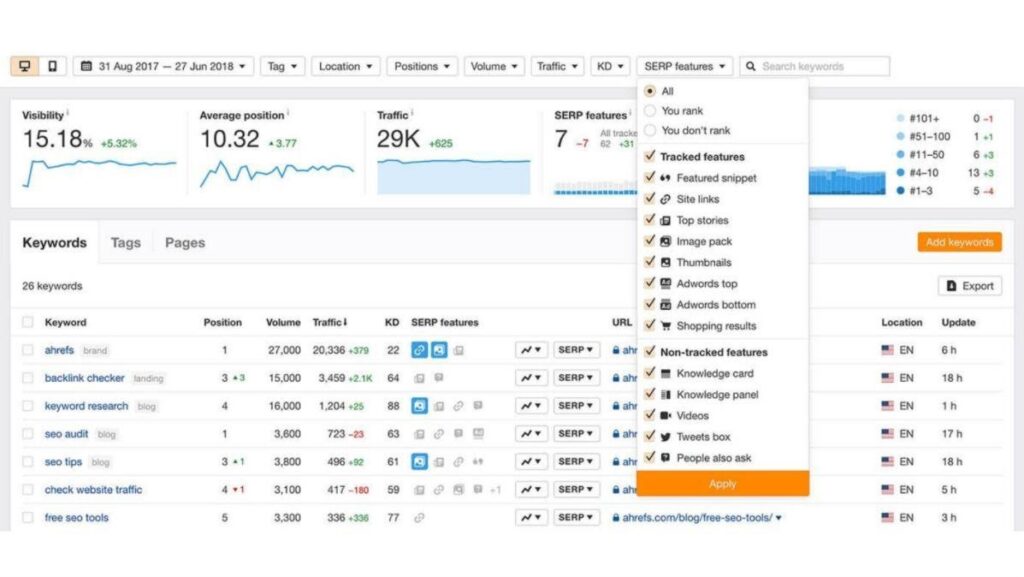
Find the low-hanging fruit
Look at the pages of your website that are already ranking pretty high but could use a boost. You can build more links, change the format, add more keywords, etc. The goal is to aim for the first three positions on the Google search, which get the majority of clicks. If you manage to rank that high, you’ll see a dramatic increase in traffic.
Here, it’s important to analyze your competitors’ sites to find out their efficient strategies and recreate them for yourself:
- What keywords are your competitors targeting?
- How are they ranking?
- What’s linking to them?
- How are they finding links?
Latent semantic indexing
Basically, this means that Google will look at your page and take context clues to figure out what your page is about.
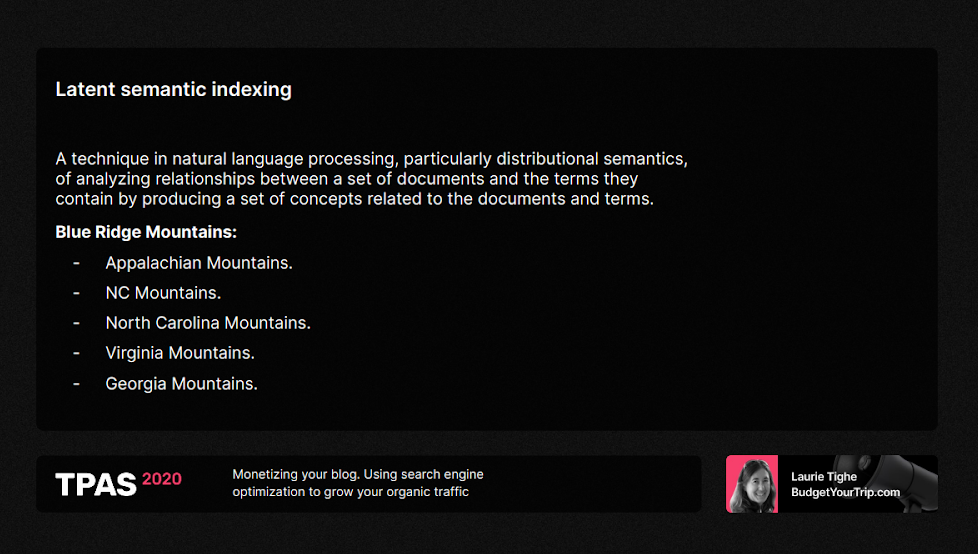
Even though there’s still no common view on how powerful latent semantic indexing is, you should use a diversity of keywords to coach Google into understanding what your page is actually about. This way you make sure that your page is shown in the right search for the relevant user.
Write quality content
Google now craves high-quality content and not auto-generated 200-word pages that many big websites used to rank well with. This offers small bloggers the opportunity to boost their rankings with well-thought content. Laurie recommends [17:43] 500 to 1,000 words on a page as this helps you move up in the rankings.
Also, Google favours expert content. Thus, it might be a good idea to write a number of articles on the same or similar topics and establish authority around that specific topic. Consider including a small section with the author’s bio to show your readers who you are and what expertise you possess. This also makes you look like an expert for them.
Good content is thorough, well thought-out, researched, and written in an understandable way. For this, break your texts into subsections with comprehensive headings that guide your readers through. Try to write posts in a natural, intuitive way, that won’t resemble a research article.
Place keywords correctly
Google prioritizes keywords based on where they are on the page and how they’re tagged. The tags might be:
- Title tags. These are typically what show up when you do your search and there’s a bold piece of text you click on.
- Header tags. If you turn something into a link, it suddenly becomes a lot more powerful in Google’s eyes.
- Image tags. Google likes these ones.
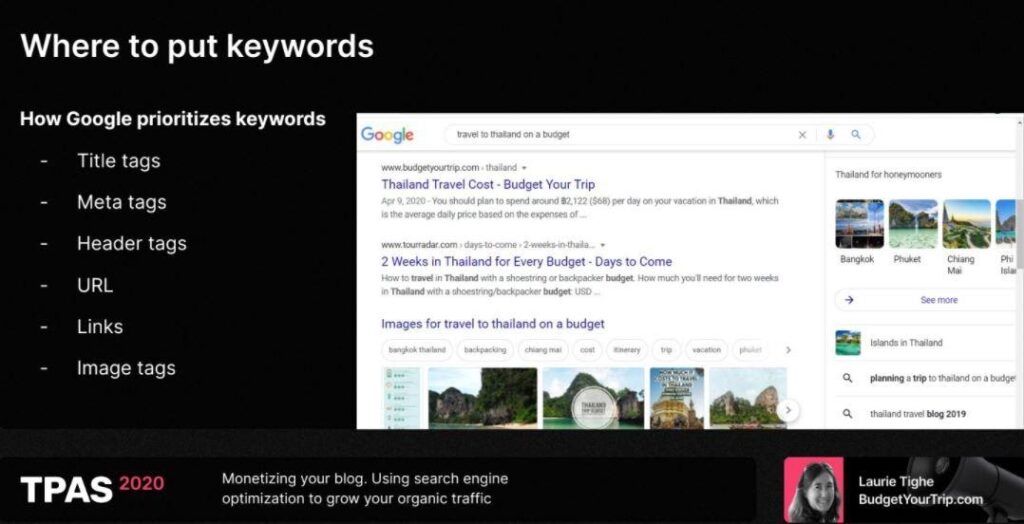
Diversify your keywords with different types of tags and that will also help you get a higher ranking.
The process of choosing keywords
To start, try thinking like travelers who are your potential readers and brainstorm the words they could be searching for. These words are your “seed keywords”. Then, expand on them depending on the specifics of your blog and your niche.
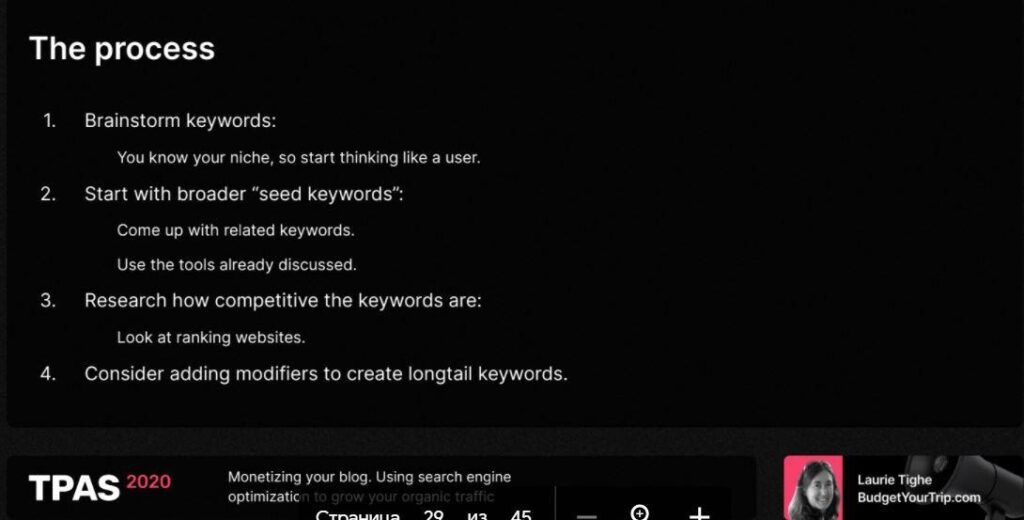
Make your keywords more descriptive using dedicated tools; for example, paid programs will help you dig deep and check how the keywords that you chose are normally used. Figure out whether they are actually competitive, what pages are ranking for those keywords, how they are ranking for those keywords and what ranking factors exist, etc.
With all those steps you can generate a page with powerful keywords that you can realistically rank for.
Diversify your revenue sources
Laurie states [24:54] that travel has been an unpredictable, changeable and a very challenging business with constant discrepancies and deviations in the traffic. Thus, you need to be ready to diversify your money sources and be adaptable to changing circumstances.
To have a back-up in case any of your revenue sources go down, keep in touch with other websites and webmasters to see what they are doing and have at least 3 or 4 alternative sources to rely on.
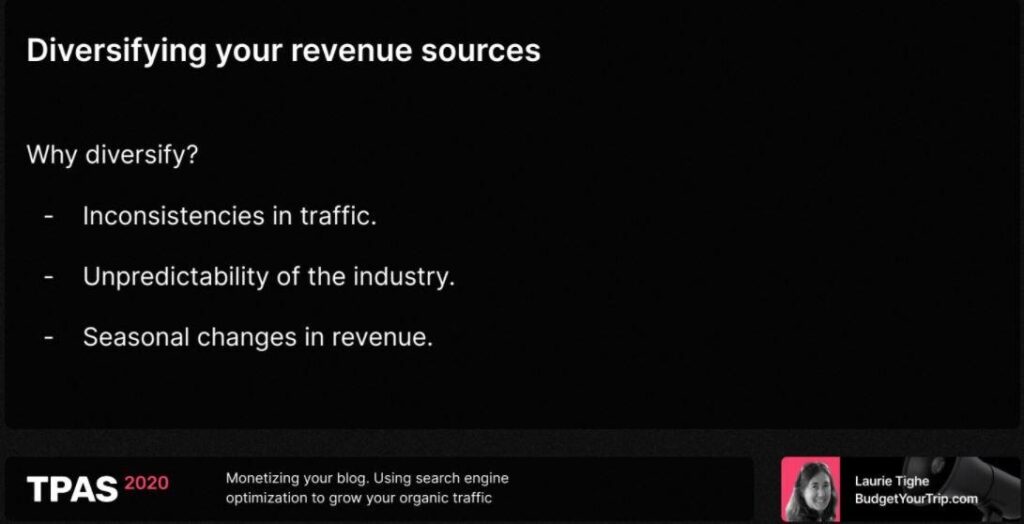
There are different revenue sources that you might find interesting and attractive for your niche.
Google AdSense
AdSense is easy to use, brings a stable revenue inflow and has basic traffic requirements (your site should be older 6 months, drive some traffic, and also have a Privacy Policy, Contact and About page). More importantly, AdSense has almost fully bounced back after the pandemic hit.
Yet, Google AdSense does not bring the highest revenue and is a bit unpredictable as you still have to conform with Google policies.
Other ad networks
Ad networks like Mediavine, Ezoic, AdThrive and Infolinks provide more personal interactions and help monetize your site. It’s important to do some testing before signing up for a long cooperation to avoid lost revenue. Ad networks often have higher RPMs than Google, but they also have stricter traffic requirements.
Affiliate programs
There is a great variety of affiliate marketing programs to join. Large programs, such as Amazon, Booking.com or Kayak, usually have a recognizable name, built-in customer base and high-level tracking systems allowing you to analyze statistics and adjust your strategy. On the other hand, there might be a lot of competition and a lack of direct and personal communication.
Niche affiliate programs are what Laurie calls low-hanging fruit, as you can easily benefit from them. Yet, such programs are not that widely known so you need to invest effort into promotion and increasing brand awareness. On the flip side, they feature less competition and provide personal contact, which helps establish a long-lasting relationship with affiliates.
Sponsored posts
Paid posts can help generate revenue as you move up in the SERPs, but there are a few particularities to know. Be aware of duplicate posts and low-quality content. Also, check whether the pages that you link to are relevant for your niche and your blog. Never compromise on quality.
Sponsored activities
Most often this revenue stream is suitable for influencers who can provide active promotion for the activities or services and have a heavy social media presence as well as a good deal of outreach. It also requires a lot of effort and work and is an extremely competitive niche. However, you can’t always make money with sponsored activities, for instance, some companies offer free stays.
All types of revenue sources differ in their mechanics and have been more or less popular at various periods of time. Laurie says [27:05] all of them have been dramatically affected by the pandemic and have not fully recovered. While before the COVID-19, Budget Your Trip was focusing on affiliate marketing, ad networks and sponsored posts (in order of importance), now Laurie and Bryan make most money off sponsored posts.
There’s a number of useful tools out there to help with SEO and website monetization:
Changes in the industry
The travel industry has been hit hard but even now we can see some positive outcomes. Thus, communication and cooperation have grown stronger and have been a powerful tool for everyone recently.
Still, you need to keep in mind that trends are dynamic and the travel environment is constantly changing. For example, short trips are now more popular than longer ones, and road trips are more in demand than those that require flights.
So, be adaptable, monitor trends and modify your target audience. Be prepared for slow growth and wait for no miracles such as overnight success.
Wrapping up
Laurie shares [39:18] some tips that are worth keeping in mind when choosing your SEO strategy and working on your website monetization.
- Be prepared to shift your website as necessary to meet the current situation and learn from your mistakes
- Even if the original idea takes off, you might need to tweak or completely shift it at any time
- Adapt quickly and figure out what causes negative consequences for you and other webmasters ASAP
- Be proactive and create high-level content
- Build backlinks from trusted sources
- Don’t panic as your traffic is going to fluctuate. When it does, try to investigate the reasons why
- Check what type of pages and keywords have been affected in a crisis situation
- Come up with a way to fix negative consequences
Presentation
You can download the presentation from the webinar at this link.



